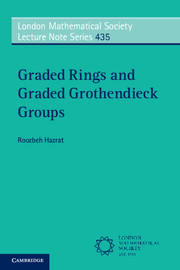3 - Graded Grothendieck groups
Published online by Cambridge University Press: 05 May 2016
Summary
Starting from a ring, the isomorphism classes of finitely generated (projective) modules with direct sum form an abelian monoid. The “enveloping group” of this monoid is called the Grothendieck group of the ring. If the ring comes equipped with an extra structure, this structure should pass to its modules and thus should be reflected in the Grothendieck group. For example, if the ring has an involution, then the Grothendieck group has a ℤ2-module structure. If the ring has a coring structure, or it is a Hopf algebra, then the Grothendieck group becomes a ring with involution thanks to the co-multiplication and antipode of the Hopf algebra.
For a Γ-graded ring A, one of the main aims of this book is to study the Grothendieck group constructed from the graded projective modules of A, called the graded Grothendieck group and denoted by K0gr (A). In fact, K0gr (A) is not just an abelian group but it also has an extra ℤ[Γ]-module structure. As we will see throughout this book, this extra structure carries substantial information about the graded ring A. In §3.1 we construct in detail the graded Grothendieck groups using the concept of group completions. Here we give a brief overview of different equivalent constructions.
For an abelian monoid V, we denote by V+ the group completion of V. This gives a left adjoint functor to the forgetful functor from the category of abelian groups to abelian monoids. When the monoid V has a Γ-module structure, where Γ is a group, then V+ inherits a natural Γ-module structure, or equivalently, ℤ[Γ]-module structure. We study this construction in §3.1.
There is also a more direct way to construct V+ which we recall here. Consider the set of symbols {[m] | m ∈ V} and let V+ be the free abelian group generated by this set modulo the relations [m] + [n] − [m+n], m, n ∈ V. There is a natural (monoid) homomorphism V ↦ V+, m → [m], which is universal. Using the universality, one can show that the group V+ obtained here coincides with the one constructed above using the group completion.
Now let Γ be a group which acts on a monoid V.
- Type
- Chapter
- Information
- Graded Rings and Graded Grothendieck Groups , pp. 122 - 179Publisher: Cambridge University PressPrint publication year: 2016
- 1
- Cited by



